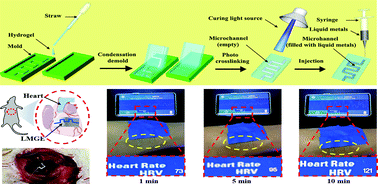Multifunctionally wearable monitoring with gelatin hydrogel electronics of liquid metals†
Abstract
Hydrogel-based flexible electronics have been of widespread interest in recent years. However, current hydrogel electronics have limitations, such as poor biocompatibility, non-reusability, low electrical response to deformation and being single-function. GelMA is a gelatin-based hydrogel that has been widely used in the biological field, such as in tissue repair and drug delivery. Could it be a good choice for high biocompatibility wearable electronics? Here, by controlling the replacement rate of amine and hydroxy functionalities, we made the common brittle GelMA into a highly stretchable hydrogel. And we report for the first time GelMA hydrogel electronics with liquid metals (LMGE), which could be fabricated by simply injecting liquid metals into the internal microchannels of the GelMA hydrogels (GelMA-30). With the unique biocompatibility, outstanding air and ion permeability, and great mechanical properties of GelMA-30, as well as the low toxicity, high conductivity and high rheology of liquid metals, LMGE can not only monitor movement changes and even the heartbeat of rats, but can also be used as a wireless monitor to supervise secretions produced during human exercise. The design of LMGE provides a general strategy for the manufacture of bio-flexible hydrogel electronics, which opens the way for the development of multi-functional biomimetic materials for integrated monitoring and repair for biomedical applications.



 Please wait while we load your content...
Please wait while we load your content...